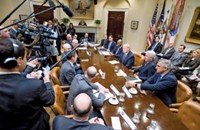Advertisement
Grab your lab coat. Let's get started
Welcome!
Welcome!
Create an account below to get 6 C&EN articles per month, receive newsletters and more - all free.
It seems this is your first time logging in online. Please enter the following information to continue.
As an ACS member you automatically get access to this site. All we need is few more details to create your reading experience.
Not you? Sign in with a different account.
Not you? Sign in with a different account.
ERROR 1
ERROR 1
ERROR 2
ERROR 2
ERROR 2
ERROR 2
ERROR 2
Password and Confirm password must match.
If you have an ACS member number, please enter it here so we can link this account to your membership. (optional)
ERROR 2
ACS values your privacy. By submitting your information, you are gaining access to C&EN and subscribing to our weekly newsletter. We use the information you provide to make your reading experience better, and we will never sell your data to third party members.
Policy
Behind the EpiPen
As headlines screamed controversy, a quiet evolution continued in drug pricing
by Rick Mullin
December 5, 2016
| A version of this story appeared in
Volume 94, Issue 48

Again in 2016, media coverage of drug pricing centered on widespread indignation over the soaring price of one product. Just as Martin Shkreli, CEO of Turing Pharmaceuticals, emerged as the poster boy for drug industry greed in 2015 after he jacked up the price of the antiparasitic Daraprim, Mylan CEO Heather Bresch took center stage this year because of big increases in the price of her company’s antiallergy pen, EpiPen.
As with Turing in 2015, Congress held hearings this year focused on Mylan. Hillary Clinton made the story a touchstone in the presidential election after tweeting on Aug. 24: “EpiPens can be the difference between life and death. There’s no justification for these price hikes.”
But some industry experts say the outrage over the EpiPen was a distracting and over-simplified take on the pricing dilemma in pharmaceuticals. The real dilemma, they say, is a basic one of how to price a drug.
The 2014 launch of Gilead Sciences’ hepatitis C drug Sovaldi, at $84,000 per course of treatment, accelerated a shift in how drug companies set prices from a model aimed at recouping R&D costs to one based on the value a drug delivers to the health care system. In the case of Sovaldi, the value is the amount of cost taken out of health care by a drug that cures patients with hepatitis C.
While there is no evidence that a new method for determining drug prices will make them more or less affordable, there is some that the shift to value-based determinations will further complicate—and politicize—the issue of drug pricing, says Peter Pitts, president of the Center for Medicine in the Public Interest and a former FDA associate commissioner.
With the rise of value-based pricing, Pitts says, the focus broadens from recouping research costs—and turning a healthy profit—to the negotiations between payers and manufacturers. Despite that change, prices continue to rise. This can be seen in the steady increase in the price of cancer drugs, not all of which are successful or come anywhere near providing a cure for a large population.
Pitts says the multistakeholder nature of drug price-setting and the impact of drug prices on the overall cost of health care have been obscured by politics and the media. “People have been looking for a villain on drug pricing, and they’ve focused on the pharmaceutical industry,” he says. “As a result, everybody got it wrong.”
Susan Garfield, a consultant in Ernst & Young’s life sciences division, agrees that media coverage is a distraction. “There has been a confluence of stories that have made emblematic the concern that there are no checks and balances on drug pricing,” she says. The concern, in turn, has triggered a “call to action” on the part of industry.
“The industry has gotten a wake-up call that pricing is not only a business issue but also a political issue,” Garfield says. And some action is shifting to the state level, she says, noting that California’s Proposition 61, the Drug Price Standards Initiative, a ballot measure that was defeated last month, would have required state agencies to pay no more than the U.S. Department of Veterans Affairs for prescriptions drugs. The combined $128 million spent by supporters and opponents of the bill made it the most expensive initiative in the U.S. this year, according to Ballotpedia, an elections data website. A similar bill, the Ohio Drug Price Standards Initiative, is on the ballot in that state for November 2017.
Even as fights raged, the quiet evolution toward value-based pricing continued this year. The result was an increased focus on the part of pharmaceutical firms, insurance companies, and regulators on managing costs across the health care system.
Garfield says,“2016 was a transformational year, in that industry has taken a much more leveled and collaborative view of pricing, understanding it needs to think in terms that resonate with other stakeholders.” Those, she said, include patients, to whom the system is far more difficult to understand than are charges of price gouging against outlier companies.




Join the conversation
Contact the reporter
Submit a Letter to the Editor for publication
Engage with us on Twitter